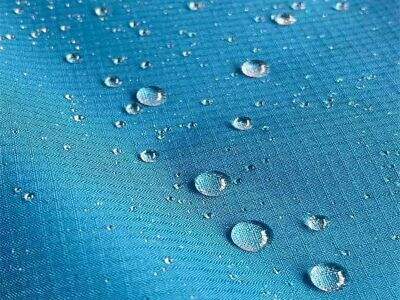Une fibre hydrofuge est comme un superman, elle repousse l'eau. Elle le fait très bien ! Inversement, la fibre hydrofuge est ton bouclier. Elle te maintiendra au sec pendant un court moment, mais finalement elle arrêtera l'eau de passer. Donc, les deux types de fibres te maintiennent au sec, mais elles le font de manière légèrement différente et pendant des périodes différentes.
En quoi l'hydrofuge et l'étanche à l'eau diffèrent-ils ?
Les fibres qui forment des perles d'eau ont un revêtement qui les rend super glissantes. Disons que tu es dans une aire de jeu et qu'il y a une grande chute, et que tu mets du savon sur la chute. Le savon t'aide à descendre, ce que tu ne pourrais pas faire sans être bloqué. C'est la même chose pour les fibres hydrofuges ; il est impossible pour l'eau de s'accrocher à elles parce qu'elles sont simplement trop glissantes. Cela signifie que lorsque'il pleut, l'eau roule directement sur ces fibres, t'aidant à rester au sec.
Les fibres hydrofuges, cependant, manquent de cette floraison. Elles ne sont pas aussi lisses que les fibres hydrofuges. C'est pourquoi l'eau peut passer après un certain temps. Donc, si vos vêtements sont faits de est un tissu résistant à l'eau , vous pourriez théoriquement rester sec pendant quelques minutes, mais finalement, l'eau entre, surtout si vous restez dehors sous la pluie assez longtemps.
Quelles sont les meilleures fibres pour les vêtements et l'équipement outdoor ?
Les fibres hydrofuges sont largement considérées comme le meilleur choix pour les vêtements et l'équipement outdoor. Elles sont conçues pour résister à l'eau stagnante plus longtemps. Si vous prévoyez de sortir lorsque'il pleut ou qu'il est humide, vous devez vérifier que vos vêtements sont faits de matériaux qui repoussent l'eau. De cette façon, vous pouvez être sûr de rester sec et au chaud quel que soit le temps.
Les fibres résistantes à l'eau peuvent être excellentes pour certains vêtements et équipements outdoor, mais elles ne sont pas aussi efficaces que les fibres hydrofuges. Cela dit, si vous allez être dehors seulement brièvement ou s'il ne pleut pas fortement, Tissu extérieur résistant à l'eau peut-être bien. Bien sûr, si vous devez rester dehors sous la pluie plus longtemps, il vaut mieux porter des vêtements imperméables.
Examiner les avantages et inconvénients des fibres hydrofuges et résistantes à l'eau :
Les fibres hydrofuges Sunfeng surpassent de telles fibres robustes car elles peuvent repousser l'eau pendant plus longtemps. Cependant, il est important de garder à l'esprit qu'elles ne sont pas infaillibles. Elles peuvent encore laisser passer un peu d'eau si elles sont exposées à une grande quantité d'eau pendant une longue période. Cela signifie qu'elles sont très efficaces pour vous garder au sec, mais doivent être utilisées avec précaution et évaluées si vous êtes pris dans une forte pluie.
Les fibres imperméables sont efficaces dans certaines situations, comme le brouillard ou la pluie légère, mais elles ne peuvent pas rivaliser avec la solidité des fibres imperméables. Donc, lorsqu'il s'agit de décider quoi porter pour des activités en plein air, considérez comment cela va se mouiller. En fin de compte, si vous voulez rester aussi au sec que possible, les fibres hydrofuges sont le meilleur choix.
Nouvelles découvertes et méthodologies :
Les chercheurs s'efforcent constamment de concevoir des solutions nouvelles et améliorées tissu imperméable . Mais une nouvelle idée passionnante est le "nano-revêtement". Il s'agit d'un type spécial de revêtement ultra-fin — en réalité mesuré en nanomètres ! Il peut même rendre les fibres plus hydrophobes qu'auparavant.
Les chercheurs travaillent également à rendre ces fibres hydrophobes plus respectueuses de l'environnement. Ils souhaitent développer des matériaux qui nous maintiennent au sec, tout en étant doux pour la planète. Dans les jours à venir, des fibres adéquates peuvent non seulement contribuer à un monde plus sec, mais aussi aider à protéger notre globe, en créant des matériaux de meilleure qualité pour les vêtements et l'équipement.
Pour conclure, si vous souhaitez rester au sec lors de vos aventures, les fibres hydrofuges sont certainement le meilleur choix. Elles agissent presque comme des superhéros pour écarter l'eau et vous protéger. Les fibres résistantes à l'eau sont utiles dans une certaine mesure, mais elles ne sont pas aussi performantes que les fibres hydrofuges. À mesure que la technologie continue d'évoluer, nous pourrions découvrir des fibres encore plus incroyables qui repoussent l'eau et offrent en plus un avantage pour l'environnement. Durable est le meilleur terme pour décrire les vêtements que nous avons conçus, avec pour objectif de vous garder au sec quelles que soient les conditions dans lesquelles vous vous trouvez !

 EN
EN



































